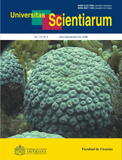Abstract
En este estudio se comparó el comportamiento bioquímico y cinético de tres cepas de Clostridium tetani, Harvard (Ha), Massachusetts (Ms) y Caracas (Ca); cepas utilizadas comúnmente en la producción del toxoide tetánico. Se realizaron pruebas bioquímicas para la identificación de los microorganismos anaerobios y se desarrollaron cultivos en reactor de 5L, bajo las siguientes condiciones: Medio Latham Mueller “Con” y “Sin” glutamato de sodio; 1% (v/v) de inóculo, pH inicial, 7.1 ± 0.2 (variable), 35ºC y 100 r.p.m. Los resultados mostraron características bioquímicas similares entre las tres cepas y la cepa control ATCC 9441. El comportamiento cinético de las cepas Ms y Ha fue similar para todos los parámetros evaluados, obteniéndose mayor productividad en cultivos suplementados con 2.5g/L de glutamato de sodio (Ms: Sin: 625Lf/L.h y Con: 658Lf/L.h; Ha: Sin: 610Lf/L.h y Con: 658Lf/L.h). La cepa Ca, produjo mayor cantidad
de biomasa (Ca: 0.5420g/L; Ms: 0.2721g/L y Ha: 0.2009g/L); sin embargo, la productividad de toxina fue menor (Sin: 174Lf/L.h y Con: 417Lf/L.h). Estos resultados descartan la utilización de la cepa Ca para la producción del toxoide, bajo las condiciones de fermentación ensayadas.
Palabras clave: Clostridium tetani, fermentación, toxina tetánica.
Abstract
In this study was compared the biochemical and kinetic behavior of three strains of Clostridium tetani: Harvard (Ha), Massachusetts (Ms) and Caracas (Ca), strains commonly used for the production of the tetanic toxoid. Biochemical tests for anaerobic microorganisms identification were done and cultures in 5L reactor were developed, under the following conditions: Latham means Mueller “With” and “Without” sodium glutamate; 1% (v/v) of inoculum, initial pH 7.1 ± 0.2 (variable), 35ºC and 100 r.p.m. The results showed similar biochemical characteristics between the strains including the ATCC 9441 control. The kinetic behavior of the Ms and Ha strains was similar for all the evaluated parameters, obtaining greater productivity in cultures supplemented with 2.5g/L of sodium glutamate (Ms: Without: 625Lf/L.h and With: 658Lf/L.h; Ha: Without: 610Lf/L.h and With: 658Lf/L.h). The Ca strain, produced greater amount of biomass (Ca: 0.5420g/L; Ms: 0.2721g/L and Ha: 0.2009g/L), nevertheless, its toxin productivity was smaller (Without: 174Lf/L.h and With: 417Lf/L.h). These results discard the use of the Ca strain for the production of the toxoid, under the assayed fermentation conditions.
Key words: Clostridium tetani, fermentation, tetanic toxin.
Univ. Sci. is registered under a Creative Commons Attribution 4.0 International Public License. Thus, this work may be reproduced, distributed, and publicly shared in digital format, as long as the names of the authors and Pontificia Universidad Javeriana are acknowledged. Others are allowed to quote, adapt, transform, auto-archive, republish, and create based on this material, for any purpose (even commercial ones), provided the authorship is duly acknowledged, a link to the original work is provided, and it is specified if changes have been made. Pontificia Universidad Javeriana does not hold the rights of published works and the authors are solely responsible for the contents of their works; they keep the moral, intellectual, privacy, and publicity rights. Approving the intervention of the work (review, copy-editing, translation, layout) and the following outreach, are granted through an use license and not through an assignment of rights. This means the journal and Pontificia Universidad Javeriana cannot be held responsible for any ethical malpractice by the authors. As a consequence of the protection granted by the use license, the journal is not required to publish recantations or modify information already published, unless the errata stems from the editorial management process. Publishing contents in this journal does not generate royalties for contributors.



